Types of Brown Wasps (With Pictures) – Identification Guide
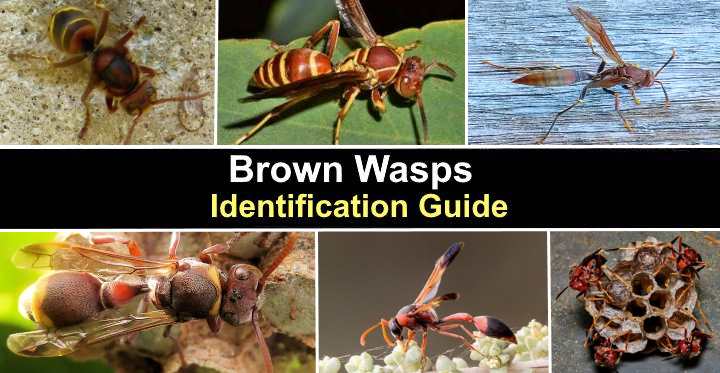
Most types of brown wasps are species of paper wasps that have mostly brown bodies with some yellow markings. These brown stinging insects are found throughout North America and can become pests from June until late fall. However, not all brown wasps are paper wasps. Other wasps with brown bodies are the European hornet and the long-tailed giant ichneumon wasp.
Species of brown wasps can be challenging to identify. For example, some brown and yellow wasps look like yellowjackets and are the same size. Additionally, the features of various types of paper wasps are similar. However, it’s good to keep brown wasps away from your garden to prevent them from giving you a nasty, painful sting.
This article is an identification guide to several species of brown wasps. Descriptions of their habits and pictures of these wasps and their paper nests will help you recognize the types of wasps in your garden.
How to Identify Brown Wasps
Brown wasps are easy to identify by their dark to light-brown body coloration. Identification features of wasps are their body size, type of compound eyes, and identifiable stripes or markings. Like all wasp species, brown wasps have six legs, a thin waist, and a pair of translucent wings.
The most common type of brown wasp is the paper wasp. Paper wasps are medium-sized insects with dark bodies and yellow or orange stripes on their abdomens. You recognize these species of wasps by the umbrella-like papery nests they build in trees, under overhangs, in attics, or under decks.
Brown Wasps vs. Hornets
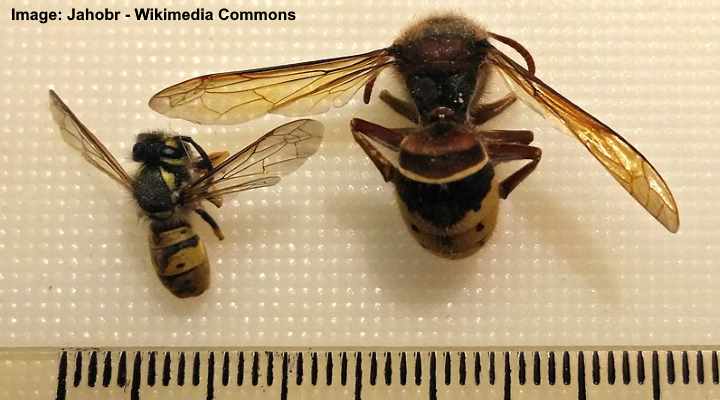
Size comparison of wasp (left) and hornet (right)
The main difference between hornets and brown wasps is their color and size. All types of hornets are wasps in the family Vespidae. For example, the European hornet is a huge brown wasp with yellowish bands on its body. Compared to a typical paper wasp, a hornet can be twice its size.
Species of paper wasps and hornets are social wasps that live in colonies. Both types of wasps can be aggressive and dangerous if you disturb their nests. Therefore, you should be careful if you notice several medium to large-sized wasps in your yard.
Facts About Brown Wasps
Brown wasps are flying winged insects in the family Vespidae and order Hymenoptera. This means that brown wasps are closely related to bees, and some wasps even look like honeybees. Many paper wasp species are brown bees and are common in gardens as they pollinate flowers, feed on insects, and build nests.
Although brown wasps and hornets are considered aggressive insects, they rarely attack humans unprovoked. However, paper wasp colonies can become dangerous if you disturb their nest. This is because the wasps send out alarm pheromones alerting other wasps to an “attack” on the nest.
However, most species of brown wasps don’t pose any stinging threat. They will generally leave you alone if you don’t disturb them or their nests. In addition, common paper wasps can be beneficial insects as they are pollinators and prey on pesky garden bugs.
Brown Wasp Habits
Most brown wasps live in colonies, making them social insects. Typically, the colony has a queen attended to by many worker wasps. The female queen wasp overwinters in tree bark. Then in spring, she starts building a nest that consists of hexagonal or circular tube-like structures in an umbrella-like shape.
Do Brown Wasps Sting?
Most species of brown wasps sting. However, only female wasps have stingers and can cause a nasty sting by injecting venom. In addition, wasp stings can be dangerous if you have an allergic reaction. In this case, it is usually best to seek prompt medical attention.
Unlike female worker wasps, male wasps, just like male bees, don’t have stingers and are entirely harmless.
Where Do Brown Wasps Live?
Paper wasps build their nests by chewing wood fibers that they mix with saliva to form paper-like nests. The females form the substance into hexagonal cells and build upside-down umbrella-shaped nests. A mature nest can hold up to 200 cells with over 5,000 active wasps.
In late fall, queens will look for secure places to spend the winter. Typically, brown queen wasps live in hollow trees, doorways, under eaves, in dense vegetation, or stacks of wood. Therefore, paper wasps can be a nuisance indoors in late fall as they look for warm places to overwinter.
What Attracts Brown Wasps to Your Yard?
Paper wasps forage on small insects like spiders, flies, caterpillar larvae, ants, and other wasps. Like all common species of wasps, paper wasps especially like sugary, sticky, or protein-rich foods. Therefore, to avoid attracting species of bees and wasps, don’t leave open trash cans in your yard.
Signs of Brown Wasp Infestation
The easiest way to know if you have a colony of brown wasps near your home is by their activity. For example, you may see several wasps hovering around cracks or crevices under your home’s overhang or near openings. Additionally, noticing paper wasp nests in trees or shrubs is a sign of an infestation.
If you find a paper wasp nest, take care not to disturb it. Instead, you should call a registered pest control company to eliminate the nests. This is especially important if you notice brown wasp activity around holes or openings in your home’s façade.
How to Get Rid of Brown Wasps
Getting rid of a colony of brown paper wasps can be challenging. Although they are not aggressive, the wasps defend their nests vigorously. Therefore, it is best to get professionals to remove the papery nests.
However, you can use wasp traps to reduce the number of these pesky flying insects in your garden.
To make a wasp trap, cut the entire neck of a soda plastic bottle and a few inches below. Then bait the bottom of the bottle with some jam, fruit juice, or sugary water. Next, flip the top of the bottle upside down and place it in the other half of the bottle.
The sugary substance will attract wasps, and they won’t be able to get out.
How to Prevent Brown Wasps
Preventing brown wasps from invading your home is critically essential. To do this, seal up any openings where paper wasps can enter your home. These could be unsealed vents, cracks in foundations, or spaces around pipes or vents that enter the building.
Additionally, wasps are looking for food in spring and summer. Therefore, clean up any outdoor pet food or fallen fruit and keep garbage cans closed.
Types of Brown Wasps (With Pictures) – Identification Guide
Brown wasps are a common type of wasp found throughout North America. Let’s look at the features of different types of brown wasps to help identify individual species.
Paper Wasps (Polistinae)
Paper wasps are medium-sized flying insects, most of which have reddish-orange to dark-brown coloration. Like all wasps, paper wasps have a thin waist between their thorax and abdomen. The brown-colored wasps measure 0.6” to 0.78” (16 – 20 mm) and have slender bodies. They are typically covered in fine setae (hairs).
Apart from their body shape, an identifying feature of paper wasps is their nests. Also called umbrella wasps, the nests look like upside-down umbrellas hanging from twigs, branches, and porch ceilings. These structures have hexagonal chambers with no papery layer wrapping around the nest.
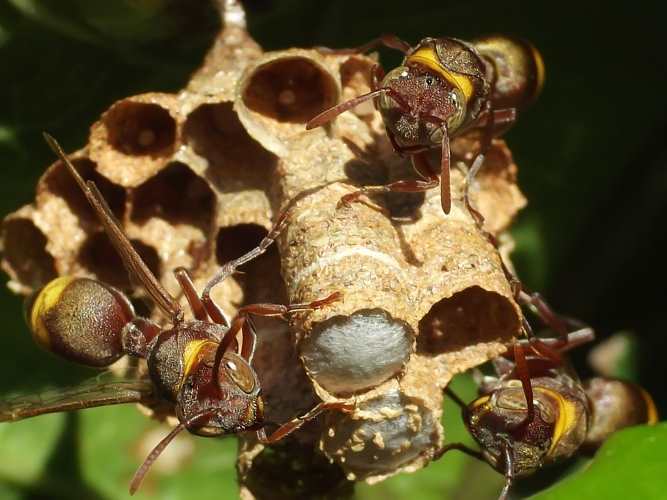
Paper wasps nest
Most species of brown paper wasps are beneficial to the environment because they pollinate plants and feed on pests like spiders, flies, caterpillars, and insect eggs and larvae. The brown wasps reproduce rapidly, meaning that a few brown wasps on your property can soon become a large colony of stinging insects.
Northern Paper Wasp (Polistes fuscatus)
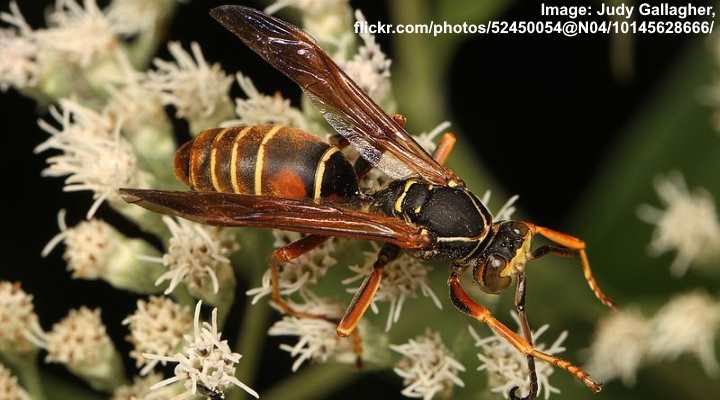
The northern paper wasp can be identified by its dark brown abdomen with yellow stripes and reddish-orange patches
The northern paper wasp is a small flying brown insect measuring 0.6” to 0.8” (15 – 20 mm) long. The brown wasp is identified by its dark brown body, yellow bands around its abdomen, brown transparent wings, and brown legs. Additionally, the brown wasp has two identifiable reddish-orange marks on its upper abdomen.
Also called the dark paper wasp or golden paper wasp, this brown species is found throughout the United States. Because of its yellow bands, it’s easy to confuse the northern paper wasp for a dark-colored yellowjacket. However, this species has a distinctive pointed head.
Brown wasp identification: The northern paper wasp has a slender dark-brown colored body with a thin waist, yellow bands, and two orange-reddish spots on its abdomen.
Guinea Paper Wasp (Polistes exclamans)
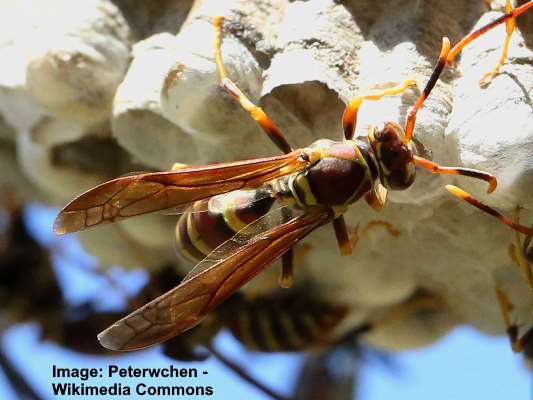
The Guinea paper wasp has a striped yellow and brown-orange body with striped legs and antennae
The Guinea paper wasp is identified by its dark brownish-orange body with several yellowish stripes on its thorax and abdomen. Other recognizable features of the brown wasps are black and orange banded antennae and bright yellow legs. Like all paper wasps, the guinea paper wasp has a flat triangular face, pear-shaped abdomen, and long wings.
The Guinea paper wasp is classified as a social wasp that is common throughout the southeastern US. Its brown coloration can depend on climatic conditions; however, it always has some type of yellow markings.
An identifying feature of male Guinea paper wasps is their bulging eyes. Typically, queens and female worker wasps have flattened faces and flat compound eyes. The brown wasps measure 0.5” to 0.6” (13 – 16 mm).
Brown wasp identification: The Guinea paper has identifiable yellowish stripes on an orange-brown body with yellow antennae with a black band.
Texas Paper Wasp (Polistes apachus)
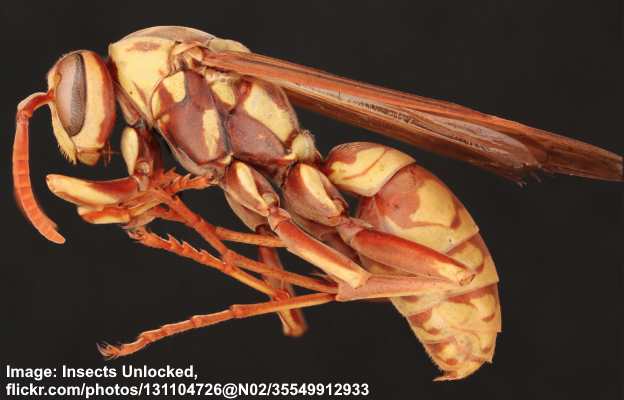
The brown and yellow Texas paper wasp is commonly found in southwestern US and is relatively big
The Texas paper wasp is a large type of golden brown wasp with creamy-yellow patches. Identifying features of this paper wasp are its golden brown and yellow abdominal stripes and two yellowish patches on the middle section. Additionally, this brightly colored paper wasp has orange antennae, wings, and legs.
Also called the southwestern Texas paper wasp or Apache wasp, the pesky brown insect grows up to 0.78” (20 mm) long. The brown wasp is common from Texas to California and often infests fruit orchards and vineyards. They are active in the southwestern US from February until December.
Brown wasp identification: The Texas paper wasp has a shiny brown body with yellow markings on its abdomen. It also has orange antennae, yellow legs, and wings.
Red Paper Wasp (Polistes carolina)
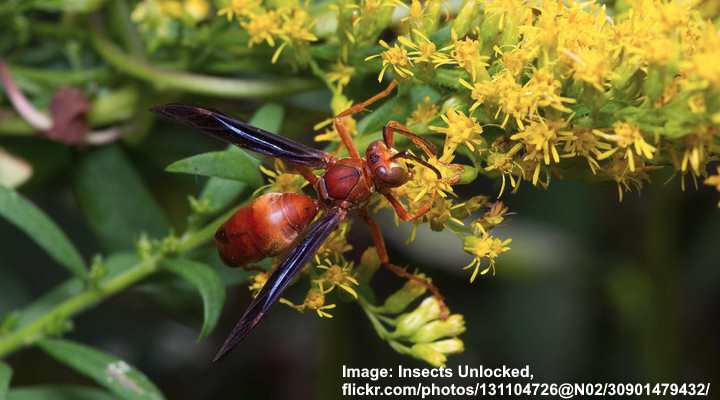
The large red paper wasp can be identified by its reddish-brown body and black wings
The red paper wasp is a large insect species identified by its reddish-brown body. The unusual red wasp has a large oval abdomen joined by a thin waist to a dark red thorax. The dark red wasp has black wings, brownish legs, and antennae.
The red paper wasp measures 1” to 1.2” (25 – 32 mm). An unusual feature is that the males and females are similarly sized. The reddish-brown paper wasp is common throughout the eastern United States, from New York to Florida — it is the only red wasp in the region.
Brown wasp identification: The red paper wasp has a shiny reddish-brown body without identifiable bands on its abdomen. It is characterized by a narrow waist, a small head, and distinctive black wings.
Polistes rubiginosus
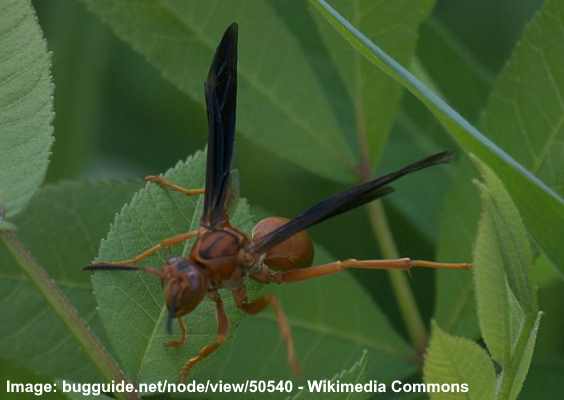
Polistes rubiginosus is a type of red paper wasp with reddish-brown body with black markings and black wings
This species of red paper wasp is recognized by its dark reddish-brown color with black markings. Like the other species of red wasp, this dark brown wasp has distinguishable black wings. It is also identified by its spindly orange legs and black markings on its thorax.
The Polistes rubiginosus has a slender, elongated body measuring 0.75” to 1” (20 – 25 mm). The native brown wasp is common throughout North America, from Florida in the east and west to Texas and Arizona.
Brown wasp identification: The Polistes rubiginous is identified by its dark reddish-brown body, black marks on its thorax, and black wings.
Giant Ichneumon Wasp (Megarhyssa macrurus)

The giant ichneumon wasp has an elongated and slender brown body with yellow and black bands
The giant ichneumon wasp is an unusual large wasp that appears to have a long tail. Characteristic features of this yellow-banded brown wasp are its slender abdomen with black and yellow stripes, long, thin antennae, and long legs. The colorful wasp also has yellow and black markings on its thorax.
As one of the longest brown wasps, the giant ichneumon wasp grows up to 2” (50 mm) long. However, together with its ovipositor (tail), it can measure 5” (130 mm) long. Although the tail gives the brown wasp a menacing appearance, the wasp is harmless to humans and doesn’t sting.
Brown wasp identification: The long-tailed giant ichneumon wasp has a reddish-brown body with bands of yellow and black markings, long legs, and wiry antennae.
European Hornet (Vespa crabro)
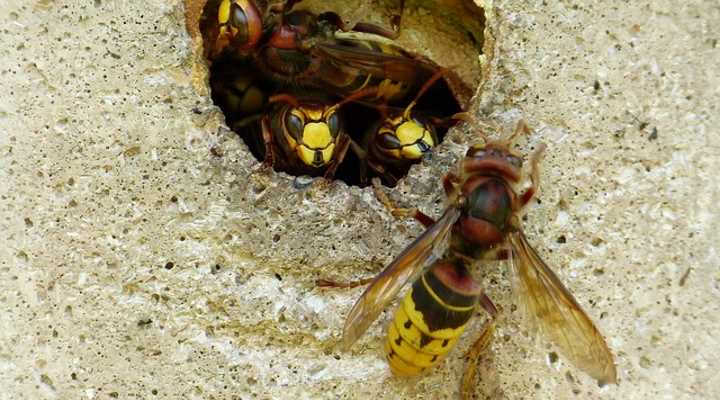
The large European hornet has black and brown-reddish thorax and its abdomen is mostly black and yellow
The European hornet is a huge brown wasp with thick yellowish bands on its abdomen separated by thin black lines. This yellow and brown hornet has reddish markings on its brown thorax, a reddish flattened head, red antennae, and legs. The large wasps have a body length between 1” and 1.4” (25 – 35 mm).
One of the characteristic features of the yellowish-brown European hornet is its C-shaped red compound eyes. In addition, the hornets tend to build large cone-like papery nests in secluded areas. Therefore, you may find them in tree hollows, attics, or a wall void.
Although they are known for being aggressive, these large brown wasps generally don’t attack humans. However, if provoked or threatened, they may sting repeatedly and aggressively. In some people, these painful stings could require medical attention.
Brown wasp identification: The European hornet is distinguished by its bright yellow and brown coloring, reddish patches on its upper abdomen and thorax, and reddish-brown legs.
Related articles:
